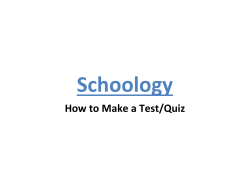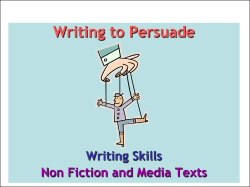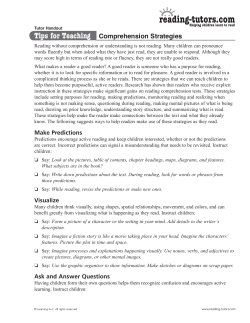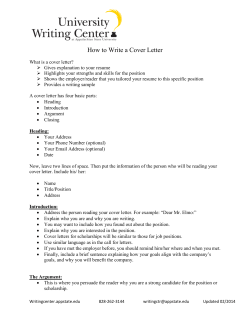
- 1 - A Parent’s Guide to Accelerated Reader™ R41856.080418
A Parent’s Guide to Accelerated Reader™ R41856.080418 -1- A Parent’s Guide to Accelerated Reader™ Questions and Answers Your child will be participating in the Accelerated Reader (AR™) program. This guide is designed to answer your questions about AR. If you have additional questions, please feel free to contact your child’s teacher or visit the Accelerated Reader website at www.renlearn.co.uk. What is Accelerated Reader (AR)? AR is a computer program that helps teachers manage and monitor children’s independent reading practice. Your child picks a book at his/her own level and reads it at his/her own pace. When finished, your child takes a short quiz on the computer - passing the quiz is an indication that your child has understood what has been read. AR gives both children and teachers feedback based on the quiz results which the teacher then uses to help the child set targets and ongoing reading practice. A Sample Quiz Question Children using AR have a free choice of the books they read, rather than having one assigned to them. This makes reading a much more enjoyable experience as they feel in control and can choose books that are interesting to them. Teachers and librarians will help your child choose books that are at an appropriate reading level. These will be challenging without being frustrating and will also be at a level at which your child can pass the quiz and experience success. If your child does not do well on the quiz, the teacher may assist him/her by: • Helping choose another book that is more appropriate • Asking more probing questions as your child reads and before he/she takes a quiz • Pairing your child with another pupil or even having the book read to your child. In most cases, children really enjoy taking the quizzes. Since they are reading books at their own reading and interest levels, they are likely to be successful. This is satisfying for most children. Best of all they learn and grow at their own pace. R41856.080418 -2- How much will my child read during the school day? According to Renaissance Learning’s research, children who read at least 20 minutes a day with a 90% comprehension rate on AR quizzes see the greatest gains. Therefore, your child should have at least 20 minutes set aside for reading during each school day. How can I help my child become a better reader? As with anything, performance improves with practice. Encourage your child to read at home. Create a culture of reading in your household by reading with your child, starting a home library, visiting your local library or bookshop on a regular basis and by letting your child see you reading. When reading with your child stop and ask questions to be sure your child comprehends what they have read and in general make a habit of discussing books that each of you has read. How does the school determine my child’s reading level? Teachers determine your child’s reading level in one of three ways: a STAR Reading™ test, a reading age estimation from a standardised test, or by using his/her best professional judgment based on his/her knowledge of your child. What is a STAR Reading test? STAR Reading is a computer based reading assessment program that uses computer-adaptive technology. Questions continually adjust to your child’s responses. If the child’s response is correct, the difficulty level is increased. If the child cannot answer a question or answers incorrectly, the difficulty level is reduced. The test uses multiple-choice questions and takes approximately 10 minutes. What is a Book Level? Book Levels are reported using the ATOS™ readability formula and represent the difficulty of the text. For example, a book level of 4.5 means that the text could likely be read by a pupil whose reading skills are at the level of a typical year five pupil. Normally, however, books are chosen based on the ZPD range recommended for each pupil by STAR Reading. What is an alternative book level (Alt BL 1 or Alt BL 2)? Renaissance Learning™ strives to make it easier for schools to use Accelerated Reader even if they use book levels based on readability formulas other than ATOS. Therefore, Renaissance Learning has created two alternative book levels based on the Degrees of Reading Power and the Lexile Framework scales. These alternative book levels are named Alt BL 1 or Alt BL 2 in the software. Schools have the option of whether to use them or rename them. The 100-point scale, Alt BL 1 that Renaissance Learning created is a transformation of a book’s ATOS level to a scale that is based on 100 pts. Renaissance Learning has also created a 2000-point scale, Alt BL 2, which is a transformation of a book’s ATOS level to a scale that is similar—but not identical—to the Lexile scale. What if my school uses Lexiles? Schools that use the Lexile readability formula to report book levels can still use Accelerated Reader. Renaissance Learning has created a 2000-point scale that is similar—but not identical—to the Lexile scale. R41856.080418 -3- What is a Zone of Proximal Development (ZPD)? In independent literature-based reading, ZPD is the range of books that will challenge a child without causing frustration or loss of motivation. Your child will receive a ZPD range after taking a STAR Reading test or teachers can use their best professional judgment to determine a ZPD. It is important for children to read with a high degree of comprehension and within his/her ZPD. ZPDs should be adjusted based on the needs and ability of your child. What are points? Every book that has an AR Reading Practice Quiz is given a points value. AR points are based on the difficulty of the book (ATOS readability level) and the length of the book (number of words). You may notice that some popular books have more points assigned to them than some classic pieces of literature. David Copperfield (Unabridged), for example is a 66-point book while Shakespeare’s MacBeth is a 4-point book. Keep in mind that this does not mean we think David Copperfield (Unabridged) is a better book or more worthwhile to read than MacBeth, only that—at 339,112 words vs. 19,048 words—it is much longer and provides more reading practice time. 4 pt. (19,048 words) 66 pt. (339,112) Children earn points on a pro rata basis depending on how well they do on the Reading Practice Quiz. For example, a pupil who takes a 5-question quiz on a book worth 1 point will earn 1 point for 5 correct answers (100%), 0.8 point for 4 correct answers (80%) and so on. A pupil who reads a book worth 5 points and takes a 10-question quiz will earn 5 points for 10 correct answers (100%) 4.5 points for 9 correct answers (90%), etc. A child needs to pass a quiz with a score of 60% or higher to earn points. R41856.080418 -4- My child is not a strong reader. Can he/she still use Accelerated Reader? Accelerated Reader helps all children become better readers from pupils with special needs to those who are gifted and talented. When children read books at their appropriate level, they experience success. Furthermore, teachers work with children to set appropriate targets based on each child’s reading level. How are Accelerated Reader point targets set? The Target-Setting Chart provides guidelines for the approximate number of AR points children should be able to earn depending on how much time they read and their reading level. Monitoring AR points earned by children and comparing them to the guideline values listed on the Target-Setting Chart enables your child’s teacher to determine how well your child is using the time provided for reading practice. How many Accelerated Reader quizzes are there? There are over 11,000 AR quizzes available and more being written every month. What kinds of quizzes are there? Accelerated Reader includes several types of quizzes designed to support the development of several reading skills. Quiz types include: Reading Practice Quizzes: Are the most common type of assessment in AR. The purpose of these quizzes is to determine whether your child has read a book, to measure his/her literal comprehension of the book and to provide immediate feedback. Each Reading Practice Quiz consists of 5, 10 or 20 multiple-choice questions depending on book level and length. Vocabulary Practice Quizzes: Measure a child’s command of vocabulary words in context while reading specific books. They are designed to reinforce vocabulary acquisition, assist with individualising vocabulary instruction and to stimulate your child’s interest in words through authentic, in-context, literature experiences. Quizzes include 5, 10 or 15 words from a particular book as well as review words from previously read books. Literacy Skills Quizzes: Are designed to give your child’s teacher information on specific reading skills. Questions are randomly generated from a 36-strong item bank resulting in 12 or 24 quiz questions. Due to item-bank technology, Literacy Skills Quizzes can be taken up to three times. Quiz questions are based on 24 specific higher order reading comprehension skills. R41856.080418 -5- How will I know if a book has an AR quiz? You can also visit the AR BookFinder at www.arbookfind.co.uk to conduct a search of all available books with AR quizzes. How can I help my child find books that are interesting to him? Visit www.arbookfind.co.uk and click on Advanced Search. By conducting an advanced search, you will be able to generate book lists that contain titles based on the criteria you enter such as Book Level, Topic, Interest Level and Fiction/Non-fiction, etc. A Screen Shot of AR Book Finder (www.arbookfind.co.uk) My child’s teacher put a book list on the web. How do I access it? Log into AR BookFinder™ at www.arbookfind.co.uk. Enter the keycode given to your child by his/her teacher and click Go to access the book list created by your child’s teacher. Is it OK for my child to read outside of her reading level? Just because a child can read the words in a book does not mean the content is appropriate. The Interest Level of the material must be considered. Interest level is based on content—a book’s themes and ideas—and indicates for which age group a book is appropriate. The chart below shows which years fall into each Interest Level. Interest Level LY—Lower Years MY—Middle Years UY—Upper Years Year Level Key Stage 1 Key Stage 2 Key Stage 3/4 These are recommendations. It is the responsibility of teachers, librarians and parents to use their best judgement when guiding children to appropriate books. R41856.080418 -6- In many cases a book’s interest level coordinates with its book level. Many books however, have a low book level but are appropriate for Upper Years and vice versa. For example, Oscar, Cat – About – Town by James Herriot and Noughts and Crosses by Malorie Blackman have a Book Level of 4.0 since both have short sentences vocabulary that is simple. Noughts and Crosses, is intended for older pupils therefore it is tagged as Upper Years while Oscar, Cat – About – Town is tagged as Lower Years. How will I know how my child is doing? A TOPS Report prints automatically after a child takes a quiz to give feedback on your child’s understanding of the book and shows cumulative data for the marking period and school year. The TOPS Report is sent home with your child. You should review the report, sign it and send it back to school with your child. If your child’s school has Accelerated Reader Advantage you can access your child’s AR information in Renaissance Place Home Connect from any web-enabled computer, so long as you have first gained access to the program from the school. Once in the program, you can view your child’s progress towards targets, points and books read. You can also access AR BookFinder to search for titles of interest. You can only access information about your own child. R41856.080418 -7- What if I have more than one child using Accelerated Reader? If you have more than one child using AR RP, the information contained in the reports is only for the child you choose to view. You must request access to the information for each child. What if I have questions about using Renaissance Place Home Connect? After logging in click on the Help icon in the upper right hand corner or contact your child’s school. R41856.080418 -8-
© Copyright 2024





















